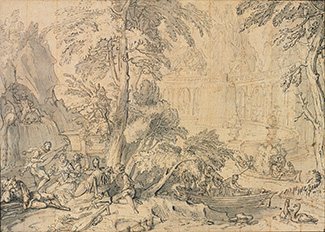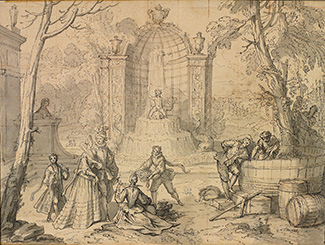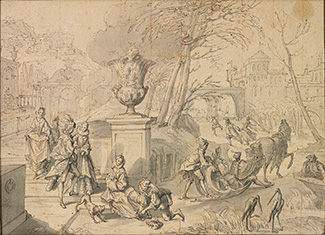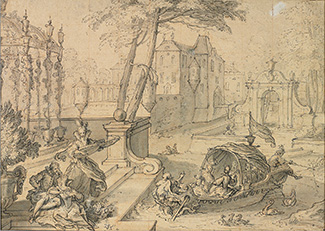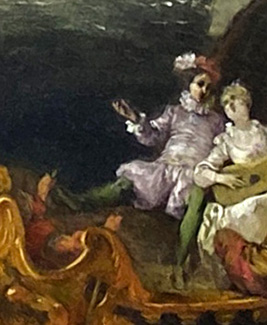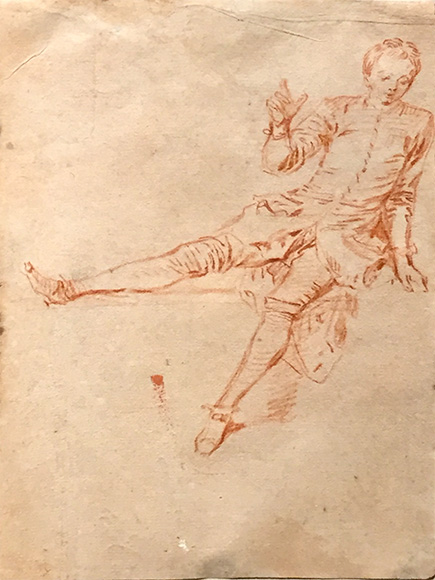
- Home Page
- Accepted
Paintings & Copies - Doubtful
Attributions - Doubtful Textual References
- Alternative
Titles - Collectors &
Museums - Bibliography
- Search Abecedario
- Watteau &
His Circle
Les Saisons Jullienne
Entered April 2025
Le Printemps
Paris, Private collection
Oil on canvas
44 × 54 cm
L’Été
Presumed lost
Oil on canvas
Appx. 44 × 54 cm
L’Automne
Presumed lost
Oil on canvas
Appx. 44 × 54 cm
L’Hiver
Presumed lost
Oil on canvas
Appx. 44 × 54 cm
ALTERNATIVE TITLES
Eine Gondelfahrt auf einem stiller Wasser im Frühling und ein Wintervergnüngen auf dem Eise
Jullienne Seasons
Les Quatre Saisons
Spring: A Pilgrimage to an Enchanted Island.
Le Stagioni Jullienne
RELATED PRINTS
Four prints after the Saisons Jullienne were engraved in reverse by four different engravers: Le Printemps was engraved by Étienne Brion; L’Été” was engraved by Jean Moyreau ; “L’Automne” was engraved by Jean Audran; and “L’Hiver”, was engraved by Nicolas de Larmessin. The set of four prints was announced for sale in the March 1732 issue, p. 550, of the Mercure de France.
Dacier and Vuaflart report that there is an engraving in reverse of the Jullienne print, Le Printemps. It was executed by George Foster (fl. 1731-1752).
PROVENANCE
Paris, collection of Jean de Jullienne (1686-1766; director of a tapestry factory) for all four of the paintings in the series. His ownership is cited in the captions on the prints. The paintings are not listed in the illustrated inventory of his collection, c. 1766, which is now in New York, the Morgan Library & Museum), nor in his probate inventory (Paris, Archives Nationales, MC/ET/XXIX/529, March 5-August 5, 1766).
The set of four paintings was apparently broken up in the eighteenth or nineteenth century. Their whereabouts cannot be traced, except for Le Printemps.
Paris, collection of a Monsieur Viguier. His sale, Paris, Chaumont, November 30, 1840, lot 71: “WATEAU (attribué à). Les délassements d'une famille: promenade sur l’eau ; au milieu du canal d'un parc, on voit dans une barque une réunion de personnages.” There is no décharge for the sale in the Archives de Paris.
Colworth (Bedfordshire), collection of Hollingworth Magniac (1786-1867, art dealer); by descent to his son Charles (1827-1891, financier and politician). His sale, London, Christie’s, July 8, 1892, lot 118: “A. WATTEAU. . . LE PRINTEMPS: a garden scene, with a fête champêtre, and figures in a gondola / 17 1/2 in. by 21 1/4 in.“ The copy of the sale catalogue in the Bibliothèque nationale is annotated “130. “ A copy of the catalogue in the Rijksbureau voor Kunsthistorische Documentatie is annotated “ May 15, 1893 for 95 guineas,” referring to the next entry.
Devonshire, collection of William Frederick Barton Massey-Mainwaring (1845-1907, politician). His sale, London, Christie’s, May 13, 1893, lot 96: “A. WATTEAU. . . LE PRINTEMPS: a garden scene, with a fête champêtre, and figures in a gondola / 18 in. by 11 ½ in. From the Magniac Collection” Sold to John Lewis Rutley.
London, art market, c. 1900, as a work by Jacques de la Joue. Sold to a private collector.
London, Christie's, July 8, 1983, lot 48 : “PROPERTY OF A GENTLEMAN. Jean Antoine Watteau. Le Printemps: a fete champêtre in a water garden with figures in a boat 12 3/4 × 18in. (32.4 × 45.7 cm.).
PROVENANCE: Jean de Julienne, Paris, but not apparently included in his sale 30 March, F.F. 1767.
ENGRAVED: L. Brillon (Dacier/Vuaflart no. 200), J. Moyreau.
Watteau painted four series of the Four Seasons; the Jullienne set, engraved by Guyot, of which the present rediscovered canvas is the only known component; the Cossé set, also known from engravings and now lost; the series of oval decorative panels first recorded in the 1743 Principe di Carignano sale, which were engraved by Huquier; and the Crozat set, again engraved, of which only the Summer at Washington can now be traced.
Although landscape backgrounds were used in all the sets, the Jullienne pictures are the only ones that are of horizontal format and could appropriately be described landscapes. Four at least, and possibly six, pictures of the seasons given to Watteau were sold in London auctions. Of these, two sold by Blackwood in 1755 are of particular relevance: / 46 A Landscape representing Spring (7 gns. to Count Nieuman) / 47 Ditto - representing Autumn (8 gns. to Sir Toshua Vanneck) / Lot 118 in the Hollingsworth Magniac sale Christie's, 4 July 1892 (sold for 130 gns. to Massey Mainwaring; his sale Christie’s, 1893, sold for 95 gns. to Turley [sic]) is described as "Le Printemps, a garden scene with a fete champêtre and figures in a gondola". However, the measurements are given as 17 ½ × 21 ¼ in. which do not correspond to those of the present lost [sic].
For general discussion of the Saisons Jullienne series see H. Adhémar, Watteau, sa vie et son oeuvre, 1950, pp. 206-7, where the engraving is incorrectly reproduced (pl. 29) as l’Été; and M. Levey, A Watteau rediscovered: “Le Printemps” for Crozat, Burlington Magazine, vol. CVI, Feb. 1964, p. 57 note 19. The series is dated 1710-11 by Ahémar and by Levey as “patently early”. Both writers suggest a collaboration with Lajoue, on the basis of the engravings. A date circa 1709 seems more probable; the landscape is possibly by another hand.” Bought in.New York, with Christophe Janet Gallery, in 1986.
London, Sotheby's, July 8, 1987, lot 82: “Antoine Watteau, 1684-1721. SPRING: A PILGRIMAGE TO AN ENCHANTED ISLAND. Oil on canvas. 32.5 by 46 cm.; 12 ¾ by 18 in. Engraved by L. Brillon and J. Moyreau.
Before the painting's reappearance in a 1983 sale, various critics, judging from the print, thought that the landscape had been made in collaboration with Jacques de Lajoue (see H. Adhemar, Watteau, sa vie, son oeuvre, 1950, pp. 206 and 207). M. Roland Michel rejects the idea of any collaboration between the two artists as an art historical myth (see R. Michel, Lajoue et l'Art Rocaille, 1982, pp. 71-75).
Provenance: Painted for Jean de Jullienne, Paris, as one of the Four Seasons; Anonymous sale, London, Christie's, 8 July 1983, lot 48.
Literature: D. Posner, Antoine Watteau, 1984, p. 279, no. 24; M. Morgan-Grasselli and P. Rosenberg, in the catalogue of the exhibition Watteau, 1984, pp. 75 and 398; M. Roland Michel, Watteau, 1984, pp. 232 and 266; M. Eidelberg, The Jullienne Spring by Antoine Watteau, in Apollo, no. 294, August 1986, pp. 98 and 103.” Bought in.Paris, with galerie Ségoura, c. 1989. With Ségoura until at least September 1997, according to Le Figaro, September 12, 1997, “Salon des Beaux-Arts : passion et érudition”, n. p..
Paris, AuctionArt, November 23, 2012, lot 97: “ANTOINE WATTEAU . . . Le Printemps, des «Saisons Julienne » / Huile sur toile / 44 x 54 cm / Vers 1710-1711 /Œuvre en rapport : /Le dessin d'Antoine Dieu. Ancienne collection Didier Aaron, Paris / La gravure d'Etienne Brillon, 1732 / Le dessin de Watteau pour le « Jeune homme assis » Prat-Rosenberg, n° 63 / Provenance : Londres, vente Christie's, 8 juillet 1983, n° 48, repr. /Londres, vente Sotheby's, 8 juillet 1987, n° 82, repr.
Bibliographie : D. Posner, Antoine Watteau, 1984, p. 279, n° 24 bis / M. Morgan Grasseli et P. Rosenberg, Exposition Watteau, Paris 1984, p.75, repr. fig.4 / M. Roland-Michel, Watteau, 1984, repr. n° 227, p. 232 / M. Eidelberg « The Julienne Spring Antoine Watteau » in Apollo, Août 1986, p. 98 / LA. Prat- P. Rosenberg, Antoine Watteau, Catalogue raisonné des dessins. Milan, 199T. I, p.100, fig. 63a. ((Les dimensions (32 x 45 cm) données depuis la vente du 8 juillet 1983 sont erronées.) 200 000 / 250 000 €”. ”Paris, Galerie Éric Coatalem; sold in Maastricht at TEFAF, 2013, to a private collector.
Private collection.
SELECT BIBLIOGRAPHY
Hédouin, "Watteau" (1845), cat. 94-97.
Hedouin, Mosaïque (1856), cat. 95-98.
Goncourt, L'Art au XVIIIème siècle (1860), 58.
Cellier, Watteau (1867), 82, 84, 87, 88.
Goncourt, Catalogue raisonné (1875), cat. 180-183.
Rosenberg, Antoine Watteau (1896), 39.
Dacier, Vuaflart, and Hérold, Jean de Jullienne et les graveurs (1921-29), 3: cat. 200-203.
Réau, “Watteau” (1928), cat. 29-32.
Adhémar, Watteau (1950), cat. 44-47.
Parker and Mathey, Watteau, son œuvre dessiné (1957), 10.
Levey, “A Watteau Rediscovered” (1964), note 19.
Macchia and Montagni, L'opera completa di Watteau (1968), cat. 22A-D.
Ferré, Watteau (1972), 1:37, cat. B64-67.
Roland Michel, Watteau (1981), cat. 16-19.
Norman, “Rare Watteau Found in a F lat” 1983, 14.
Roland Michel, Watteau (1984), 214, 232, 266.
Washington, Paris, Berlin, Watteau 1684-1721 (1984), 35, 73.
Posner, Watteau (1984), 26, 128, 145, 150, 279.
Eidelberg, “The Jullienne Spring” (1986), 98-103.
Vidal, Watteau’s Painted Conversations (1992), 70.
Rosenberg and Prat, Watteau, Catalogue raisonné des dessins (1996), 63.
Michel, Le «célèbre Watteau» (2008), 130, 131, 152, 182.
Valenciennes, Watteau et la fête galante (2004), cat. 32 and 37-40.
Linhares, Prat, La collection Chennevières (2007), cat. C746-749.
Glorieux, Watteau (2011), 100.
Paunet, Antoine Dieu (2018), 7-8, cat. 54-58.
Eidelberg, “Watteau, A Good but Difficult Friend“ (2022), 47.
Paunet, “Antoine Dieu, Antoine Watteau” (2022), 110.
RELATED DRAWINGS
As customary in collaborative efforts between Antoine Dieu and Watteau, Dieu established the overall designs for the four compositions in a series of four complete compositional studies. drawings. Dieu’s drawings were wrongly attributed to Sébastien Leclerc the Elder (1637-1714) when they were in the collection of Philippe de Chennevières, and still when they were sold in one of the auctions of his collection (April 7, 1900, lot 289, sold for 555 francs to Thévenin). The four drawings resurfaced in 1981, still attributed to Leclerc (Paris, Laurin-Guilloux-Buffetaud-Tailleur. December 7, 1981, lot 5). By sometime in 1986, the drawings were reattributed to Dieu.
The four drawings were squared to ease the transfer to the canvases. Roland Michel proposed that they had been squared to aid the Jullienne team of engravers. This is unlikely, especially since the drawings were not engraved. Only Watteau’s paintings were engraved.
Watteau changed numerous elements from the drawings to the final compositions. For example, in the painting Le Printemps, a young man is seated in the boat, but he is absent from Dieu’s compositional drawing. Watteau’s study for this figure has survived and is presently with Galerie Coatalem (Rosenberg and Prat 63). This suggests that when Watteau wanted to supplement Dieu’s initial scheme, he turned to the same portfolio of drawings that he relied on for his fêtes galantes. The drawing bears traces of paint on both recto and verso, red and white paint on the recto, blue on the verso. These traces suggest that at some time the sheet was used in the context of an artist’s studio.
REMARKS
Until the second half of the twentieth century, Watteau scholars unquestioningly accepted the attribution of these representations of the four seasons, especially since they were included in Jean de Jullienne’s Oeuvre gravé. However, the compoitions s aroused little interest—in large measure because the actual Watteau canvases were not known. Curiously, around 1900 when Le Printemps was on the London market, it was presented as a work by Jacques de la Joue. Did Adhémar know something of this idea a half century later when she too proposed that while the figures might be by Watteau, the landscapes were by Jacques de la Joue, an artist whose œuvre interested her, and who was recorded (falsely) as having collaborated with Watteau? Her proposal found little support, but was still being voiced when Le Printemps came up at auction in 1983. However, the association with Lajoue was not convincing since the sixteenth-century architecture was unrelated to the Baroque and Rococo fantasies that delighted La Joue . However, as could be seen when the actual painting of Le Printemps surfaced in 1983, the brushwork and palette of the landscape matched the foreground. No evidence of a separation of hands was visible. In an equally arbitrary manner, Jean Ferré proposed that Watteau collaborated with Claude Gillot to create the Saisons Jullienne. There is no basis for such an idea.
Our understanding of the Saisons Jullienne changed dramatically in the 1980s when the four compositional studies for these compositions came to light and it was realized that the drawings were by Antoine Dieu. This was exciting news in several ways. It was well established that Watteau had collaborated with Dieu on another occasion: when Dieu hade been commissioned to compose and paint an event in the life of Louis XIV, Louis XIIII met ant le cordon bleu au duc de Bourgogne. This second association with Dieu, with Dieu establishing the major lines of the composition and Watteau modifying individual figures, throws unexpected light on aspects of Watteau’s early career when he worked essentially as a journeyman, assisting older, more recognized artists. The Saisons Jullienne afford us insight into how Watteau shared the responsibilities in such partnerships with other artists such as Gillot, Audran, Spoede and others.
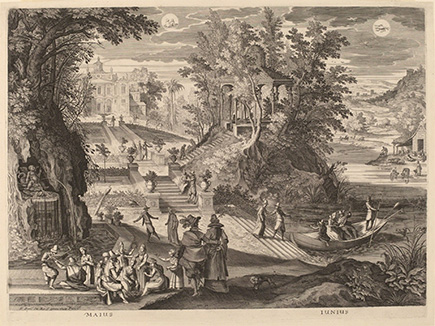
Aegidius Sadeler after Paul Bril, May and June, 1615, engraving.
When designing the Saisons Jullienne , Dieu evidently was heavily influenced by Flemish sixteenth- and early seventeenth- century masters such as Paul Bril, Peter Stevens, David Vinckboons. and others. The choices of seasonal activities, the costumes, the buildings—all these elements closely follow old Netherlandish traditions. Such antiquarianism reflect s Parisiian taste in the early eighteenth century, and while not particularly significant for Dieu’s development, it has great importance for Watteau’s. References to these older modes of dress and setting permeated his early fêtes galantes and are still present in later compositions.
This background left critics doubtful when the painting appeared on the art market in the 1980s. It was claimed that, at best, Watteau painted the foreground, and someone else painted the background (often citing Lajoüe as a candidate, after Adhémar). Recent scholarship agrees on that Watteau painted the canvas, relying on Dieu’s designs. This interpretation can be reviewed, after the examination of the painting. There is no differentiation in brush work or palette, between foreground and background. The consistency in handling establishes that it was made by only one hand, namely Watteau’s.
It is agreed that Les Saisons Jullienne is from the early years of Watteau’s career, though the choice of which year has varied considerably. Mathey dated them as early as 1704-5, as did Levey. Macchia and Montagni opted for 1706-8, followed by Marianne Roland Michel who at first chose 1706-10 but latter changed her opinion, after the reemergence of the drawings, to 1708-10. Adhémar dated the paintings 1710-11. After the discovery of Le Printemps, there has been general agreement for a dating around 1709-10. Also, in light of Dieu and Watteau’s collaboration on Louis XIIII metant le cordon bleu…, a painting that Dieu was commisionned to execute in 1710, it is tempting to consider that the Saisons Jullienne was painted around that same time or slightly later, after he returned from Valenciennes.
Occasionally, the Saisons Jullienne have been identified with paintings that were on the London market in the nineteenth century, but their descriptions are insufficiently precise. For example, a Watteau painting described as a ball was with the London art dealer John Lewis Rutley (1836-1921), as was cited in Bazaar, The Exchange and Mart, 48 (May 17, 1893), p. 875, and this work has sometimes been identified with Le Printemps, but Le Bal seems an unlikely description of Le Printemps. In the same way, two paintings attributed to Watteau were sold by Blackwood of London, a landscape representing Spring and another representing Autumn ; the first could be our picture, which early on went to London , but the association is not secure.
For copies of Saisons Jullienne, CLICK HERE
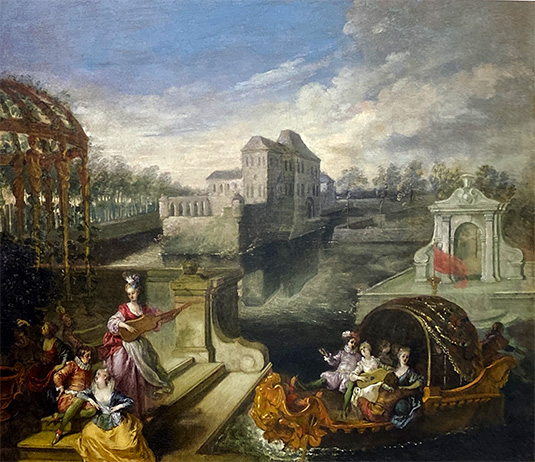

-sampled.jpg)
-sampled.jpg)
-sampled.jpg)
-sampled.jpg)
